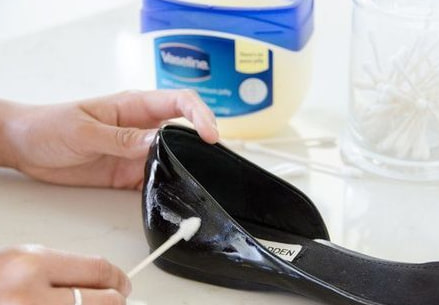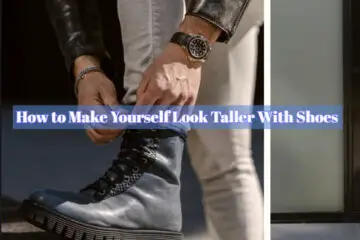Scuff marks on shoes can really ruin their look. While scuffs add character to leather shoes, on plastic shoes they just look…well, scuffed.
The good news is that plastic shoes are highly scuffable – but also highly scrubbable! With a bit of elbow grease and household cleaners, you can make scuffs on plastic shoes disappear.
In this post, we’ll explore 10 surprisingly easy ways to remove ugly scuff marks from plastic shoes and make them look brand new again. From pantry staples to multipurpose cleaners, we’ve got you covered.
With these simple methods, you can restore and revive your plastic kicks in no time. So don’t despair over scuffs – get ready to erase them! Let’s get those shoes looking snazzy again.

10 Ways to Easily Get Rid of Scuff Marks on Plastic Shoes
This section will walk you through 10 simple and effective ways to remove scuff marks from plastic shoes and get them looking fresh. Let’s kick things off!
1. Apply a Baking Soda Paste
Baking soda is mildly abrasive so it works great to scrub away scuff marks on plastic. Make a paste by mixing baking soda with a bit of water. Use an old toothbrush or cotton swab to gently rub the paste onto the scuffed area using circular motions. Let it sit for 5-10 minutes before wiping away with a damp cloth. The baking soda will lift and absorb the scuff marks. It may take a few applications but it works like a charm.
2. Use Hand Sanitizer
Another mild abrasive that can zap scuffs – hand sanitiser! Simply put some on a cotton ball or paper towel and rub it over the scuffed spot. The alcohol in the sanitiser breaks down the scuff marks. Wipe it off with a clean cloth. For stubborn marks, let the sanitiser sit for a few minutes before rubbing. The marks will lift right off.
3. Reach for a Magic Eraser
These handy cleaning blocks work great on plastic shoes. Get the shoe wet first, then gently rub a magic eraser sponge over the scuffed parts to essentially erase the marks. You can also try delicately scraping with the edge of the eraser to dig into tough marks. These melamine sponges lift scuffs through friction, not chemicals.
4. Soften with Petroleum Jelly
Here’s an oldie but goodie home remedy – petroleum jelly! Apply a generous layer of plain old Vaseline onto the scuffed plastic and let it soak in for 10-15 minutes. This softens and lifts the abrasions. Then take a soft cloth and gently buff away the jelly and scuffs. The petroleum jelly conditions the plastic too. No heavy scrubbing needed!
5. Harness the Power of Essential Oils
Certain essential oils like lavender, lemon and tea tree oil naturally break down scuffs through their cleansing properties. Just put a couple drops of oil onto a cotton ball and massage it onto the shoe scuffs. Let it penetrate for 5 minutes before buffing off with a soft cloth. The natural solvents in the oils dissolve scuff marks without dulling the shoe’s surface.
6. Bust Out the Toothpaste
Believe it or not, toothpaste (the white paste kind, not gel) can clean up scuffed shoes courtesy of its mild abrasives. Rub a dab of toothpaste onto the affected area using a toothbrush or cotton swab. Give it a few minutes to work before gently scrubbing and then wiping clean with a damp cloth. The toothpaste will slowly lift the scuff layer so keep at it.
7. Call in WD-40
The lubricant/solvent WD-40 is great for dissolving scuffs on hard plastic surfaces like shoes. Spray or apply a little WD-40 directly onto the scuffed parts of the shoe. Let it sit briefly to penetrate before wiping clean with a soft cloth. It may take some elbow grease for tough scuffs. Bonus – it adds a nice subtle sheen!
8. Break Out Baby Wipes
Surprisingly, something as gentle as baby wipes can tackle plastic shoe scuffs. Their mild cleaning formula and soft texture let you scrub away marks without damaging the shoes. Wipe and rub the scuffed area gently with the textured side of a baby wipe. Flip to the soft side and buff the area clean. The wipes lift dirt while conditioning the surface.
9. Use Nail Polish Remover
The acetone in nail polish remover is an effective solvent that can dissolve scuffs on plastic shoes when applied properly. Dip a cotton ball in a bit of remover and gently rub the scuffed parts of the shoe. Acetone is potent so don’t let it sit too long before wiping off. Reapply if needed. It will strip the blemishes away.
10. Shine On with Shoe Polish
For light scuffs, sometimes a little shoe polish can hide marks well enough. Use polish that matches your shoes and buff it into scuffs using a soft rag. Apply gently with circular motions. Let the polish fully dry before buffing again with a clean cloth. As you shine the shoe, the polish will mask scuffed patches. It provides a temporary fix or hides marks between deeper cleanings.
Conclusion
Scuff marks don’t have to be the end of the world for your favourite plastic shoes. With a range of effective home remedies, you can erase unsightly scratches and scuffs to restore their original shine. From handy baking soda to the hidden power of WD-40, you’ve got inexpensive and accessible options.
Test products first and stick to gentle scrubbing to avoid further damaging the shoe’s surface. With some trial and error, you’ll discover which method works best for your scuff situation and shoe material. Invest a few minutes to touch up marks as soon as they happen to keep shoes looking their best.
With these simple, affordable fixes in your arsenal, you can keep plastic shoes looking like new for longer. So go ahead and buff away those scuffs – no need to hide your shoes away until they can be revived and return to regular rotation again. Just remember to scuff carefully next time!
FAQ
What are the best home remedies for removing scuffs from plastic shoes?
Some of the most effective home remedies include baking soda paste, hand sanitiser, petroleum jelly, essential oils, magic eraser sponges, toothpaste, baby wipes, nail polish remover and WD-40 lubricant.
How should you prep plastic shoes to remove scuff marks?
Prep the shoes by removing any loose dirt or debris first with a soft brush. Clean the scuffed area with soap and water and let fully dry before applying any cleaning solutions. Test products first on inconspicuous spots.
What household items can damage plastic shoes when trying to remove scuffs?
Avoid harsh abrasives like stiff bristle brushes or scouring pads as they may further scratch the plastic surface. Acetone and alcohol can strip plastic shoes if left on too long. Limit their use. Avoid bleach or other harsh chemicals that can discolour shoes.
How can you avoid getting scuff marks on plastic shoes in the first place?
- Wear them primarily indoors or on dry days
- Add sole protectors on shoe bottoms for slip resistance
- Apply a protectant sealant spray to repel marks
- Walk carefully and avoid dragging feet on ground
- Wipe shoes down after wearing to remove dirt right away
Is there a way to permanently scuff-proof plastic shoes?
Not completely, but applying a thin layer of clear nail polish or acrylic sealant spray to the shoe exterior can help protect the surface from abrasions and marks. Reapply occasionally as needed.
Will shoe polish work to cover up scuffs on plastic shoes?
Shoe polish can temporarily mask very light scuffs but won’t fully remove or repair them. Use polish sparingly and buff gently so as not to scratch the plastic worse.
Can you sand out scuff marks on plastic shoes?
Lightly sanding with fine grit sandpaper may reduce the appearance of scuffs but risks permanently damaging the shoe by scratching or stripping the plastic finish. Use sanding carefully only on very minor marks.
How do you clean magic eraser sponges after using them on scuffed shoes?
Rinse thoroughly then allow to air dry. Old eraser residue could transfer to the shoes. Once fully dry, lightly brush eraser surface with a stiff nylon brush to refresh.



